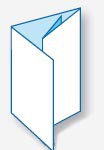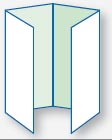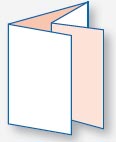There is an almost unlimited number of ways a piece of paper can be folded. To communicate the way your brochure should be folded it is important to use accurate descriptions. Shown below are some of the most common folding methods and terms.
When designing your publication, please keep in mind that folding is a mechanical process that may show slight variations depending on factors such as paper thickness.
 Half Fold
Half Fold
Most common type of fold. Examples: A3 fold to A4 or A4 fold to A5.
 Roll Fold
Roll Fold
Panels fold in on each other. Each panel, from the outside in must be successively smaller to allow for the paper thickness.
G ate Fold
ate Fold
Two end panels fold inward, then folds again vertically down centre of page.
 Parallel Fold
Parallel Fold
This type of fold requires the finished piece to be folded in half, then in half again – final, folded size is one quarter the original width by the same height.
 3 Panel Fold
3 Panel Fold
A common layout is the three-panel, two fold brochure on A4 size paper that folds down to fit into an envelope. Example: A4 fold to DL.
 Concertina or Z Fold
Concertina or Z Fold
Panels fold on top of each other like an accordion. Called a Z fold when there are 3 panels. The resulting brochure can be unfolded and laid flat to be read from side to side.

